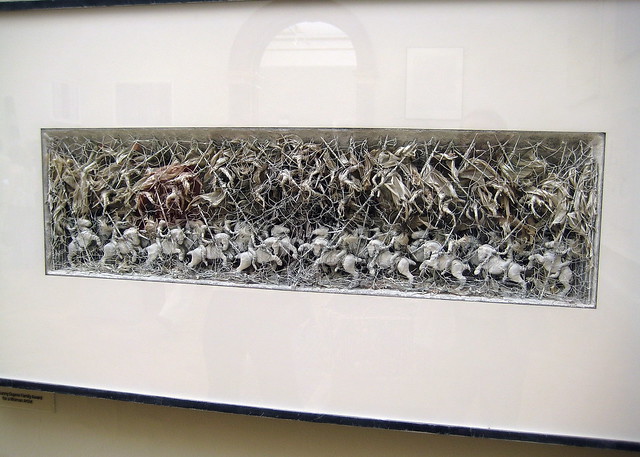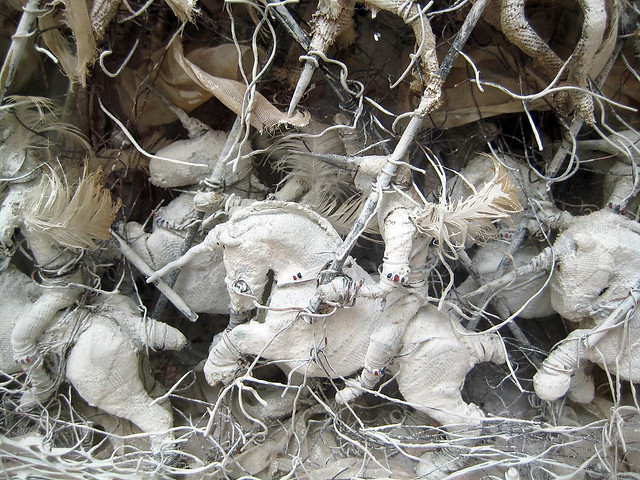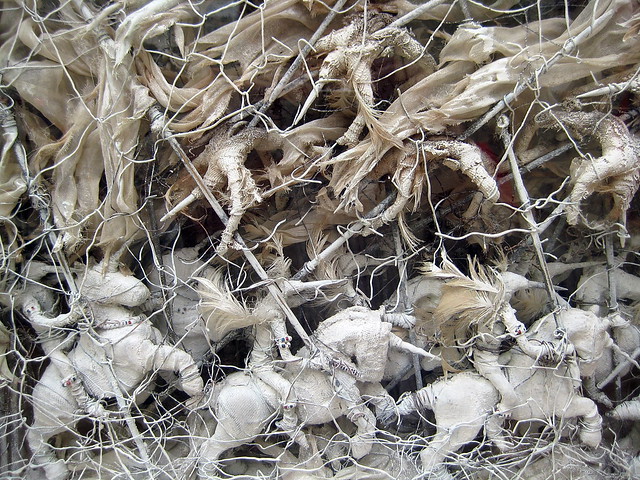Recently i have visited the Royal Academy of Arts in London to see the annual Summer Exhibition, which consists of a large collection of all types of art from hundreds of different artists. 'Held annually since the founding of the Royal Academy of Arts in 1768, the Summer Exhibition is the world's largest open- submission contemporary art exhibition. Now in its 244th year, it continues the tradition of inspiring debate and displaying work in all styles and media, including painting, printmaking, photography, sculpture, architectural models, artists' books and film. The Summer Exhibition attracts a high volume of entrants annually with over 11,000 entries received this year. The exhibition features over 1,400 works chosen by the Summer Exhibition commitee.
In this post, i will pick out some of the works i liked the most which will also give you an idea of how wide the variety of work was that was exhibited.

Sweetly The Air Flew Overhead: Battle With Unicorns No.9, By Cathy De Monchaux, Mixed Media
Personally one of the most spectacular time-consuming pieces of the entire show in my opinion, this work depicts a battle between fantasy creatures such as unicorns, made from elastoplast, copper wire, brass, beads, feathers, silk, paint and glass. The intricacy was extroadinary, and seemed to repeat patterns and lines of the creatures in a never-ending 3-dimensional 'painting'. In this sculpture, Cathy de Monchaux combines opposites, hard and rough contrast with smooth and soft. The forms also work in opposition, with spikes or jagged edges contrasting with curves and padded surfaces. Her imagery implies harshness and softness of nature which simultaneously attract and repel. The elegant form of a unicorn is changed into something blood-thirsty and heartless.



After Henry James, By Tom Phillips, Epson and Silkscreen
Tom Phillips is an artist who looks at ornamental forms of writing, taking inspiration from quotes, and phrases from books and poetry, to create colourful and thoughtful pieces. Paying so much attention to one set of words in a piece of work really emphasises what is being said and makes you wonder at the words instead of dismissing them as you might do if they were written normally in a book. It shows a lot about the artist's mind and messages he wants to convey to the people that look at his work. Elected to the Royal Academy in 1984, Phillips went on to chair the Academy's Library and its Exhibition Committee from 1995 to 2007. He also served as a trustee for the National Portrait Gallery and British Museum. His huge involvement in these art galleries and the experiences and memories from these years of his life reflect in his work, some of the phrases used have been written by himself from what he knows about various life occurances.

Pure To Another (Portrait Of Brian Kennedy), By Colin Davidson, Oil On Linen
Colin Davidson is a contemporary artist, living and working near Belfast, Northern Ireland. Since graduating with a first class honours degree from the Art and Design Faculty at the University of Ulster in 1991, Colin Davidson has exhibited extensively in London, New York, Milan and across Ireland. His latest body of work is a selection of portraits of writers and actors, a portrait of Brian Kennedy being displayed at the Summer Exhibition. I have picked this work to blog about because although it may look like any other ordinary realist portrait of a man, seeing the work in reality was a completely different experience. Parts of the painting were very detailed while others were left rather hazy and blurred as though the head in the portrait was actually moving. Something else i noticed that stood out from other portraits i have seen was the composition of the eyes. Although the composition of the head looks to be almost directly angled forward, the eyes are not looking directly at the viewer as a majority of portraits of this formation do. This gave the painting quite a sombre mood as though the subject being painted did not want to be there or was thinking of something else.
Stourhead 30th June 2003, By Adrian Berg, Oil
Adrian Berg's work celebrated nature in its most cultivated form, and throughout his life he was fascinated by England’s parks and gardens; among those he recorded were Windsor, Kew, Dartington, Nymans, Stourhead and Sheffield Park. 'However narrow the subject matter, Berg found new ways of recording it and of examining the effects of the seasons on the landscape. He experimented with different dilutions of paint, studied the ways in which water alters the forms of the trees it reflects, and intensified or reduced the richness of colour to extract the maximum expressive potential from the subject.' Much of his work shows the same subject matter, his most popular composition: lush green landscapes reflected in water. He was elected a Royal Academician in 1992 and appointed an Honorary Fellow of the Royal College of Art in 1994. Stourhead 30th June 2003 was shown in the Royal Academy Summer Exhibition and i thought his work was very child-like and experimental, playing around with different paint dilutions and studying the way in which water alters the forms of the trees it reflects.


Feather Child 1, By Lucy Glendinning, Mixed Media
Perhaps one of the most unnerving peices i have seen in the exhibition this year is Lucy Glendinning's Feather Child 1 showing the lying, fetal positioned body of a child made entirely of white an brown feathers. Most of her work experiments with different types and colour of feathers covering the bodies of children and when looking at her work, some moments it made me feel unsettled because seeing it in reality it was just so different from anything i had ever seen before, the figure seemed to look vulnerable yet quite scary at the same time. It seemed to me that i didnt like looking at it because it made me feel unsettled but i loved looking at it at the same time, the brown feathers being concentrated on the face an ear made it feel very unhuman. Accompanying the work, Lucy Glendinning has twinned a poem:
Will we be able to resist it?
Of coursed not, I say.
The endless opportunity
to better our future,
to improve the human race,
and solve the endless
problems of more.
Will we be able to resist it?
Once we have cured the sick,
to improve the well,
what fun we’ll have
making useful modifications
improvements and special vocations.
Will we be able to resist it?
A decoration applied with
a gene, not a needle.
To breath under water
Wouldn't that be useful,
or to fly who could resist that.
To be special we all want it,
once we are no longer a child.
Will we be able to resist it?
Is evolution ours now?
Will it be like most,
money will buy the prize?
You will need to be
something like a Rothschild
to be able to fly.
Or to glow in the dark
a Geldof or a Spark.
Is it about to change,
are we to be in charge?





